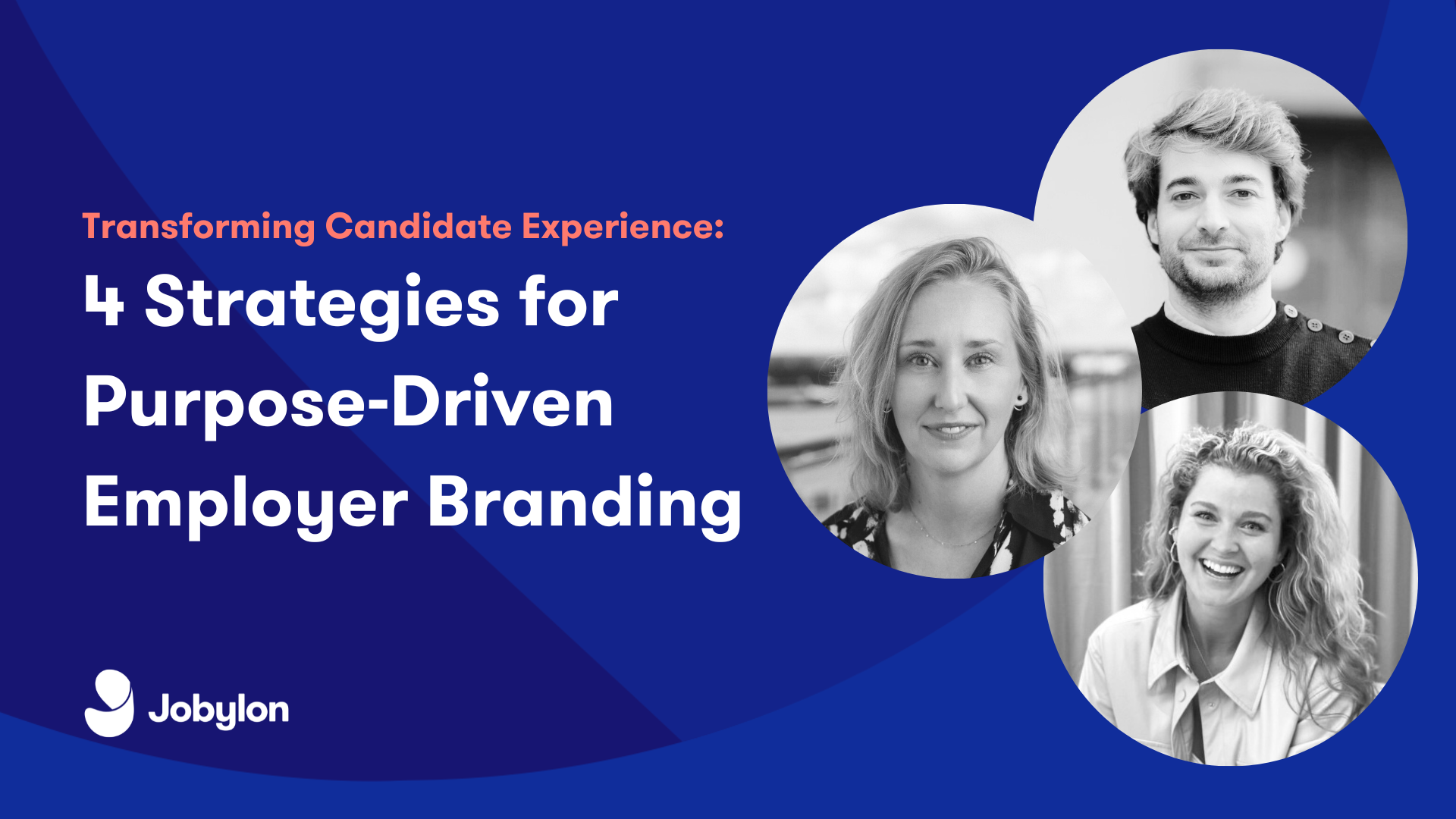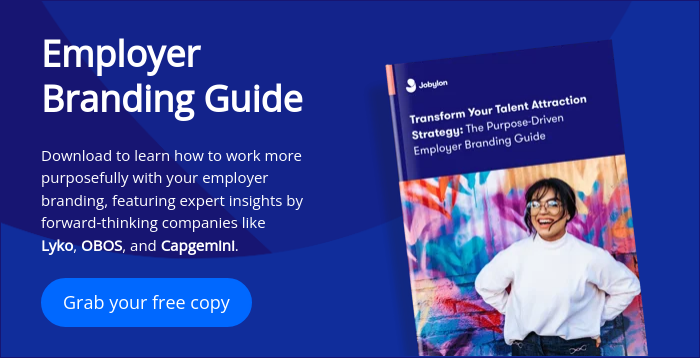Employer branding is nothing without purpose. Nowadays, candidates seek a genuine connection with a company's values, and want to be able to envision themselves as part of the team. Purpose goes beyond shaping company culture — it's a vital factor when building a long-lasting employer brand and fostering relationships with candidates.

In our webinar 4 strategies for purpose-driven employer branding, our three industry experts Dorotea Gawek (Head of Employer Branding Nordics, Capgemini), Benjamin Kesler (CEO & Co-founder, Local Glimpse), Karin Bergström (VP People & Culture, Jobylon) explore the four essential elements for identifying, integrating and fostering a purpose-driven employer brand. Are you short on time but still want to take part in the valuable insights, we got you covered! Let’s dive into the key takeaways:
1. How to seamlessly integrate your organisation's purpose into your brand
Karin Bergström: Purpose is all about creating meaningfulness, and ensuring that each and every employee feels like their work creates value. That needs to be crystal clear. This clarity starts with educating managers, enabling them to help their teams understand their contributions. It’s not enough to have an overall company strategy; you need to connect metrics to individuals so they can understand how they’re contributing.
Dorotea Gawek: For a big corporation like Capgemini, the purpose isn’t defined, it’s lived. Values can’t be created through words alone, but need to be lived and embraced in the company culture and everyday work life. It’s not a quick fix; it's a long-term commitment that requires the proper integration and time for employees to fully adopt and embrace.
Benjamin Kesler: Infusing purpose into an employer brand shouldn’t be a seamless process, In fact, that shouldn’t even be the ideal goal. It is one of the most common issues he sees with his clients–they try to get everyone on board and aligned with the grand mission. For employers, that might seem like a reasonable way to motivate employees, but candidates might find it hard to relate to or understand how their role contributes to the mission. Employees should be encouraged to live and express the purpose in their own way.
2. How to leverage HR-tech to optimise candidate engagement
Benjamin Kesler: Many companies are not fully utilising their ATS. They often miss the opportunity to segment candidates into various talent pools and activate them when needed. Additionally, they tend to overlook the advanced features offered by their ATS. It’s essential to explore the capabilities within the backend of your ATS and leverage what’s already there.
Dorotea Gawek: Even if Capgemini already has access to future technology, we still prioritise what we call “moments that matter”. Throughout the candidate experience, we bring this concept to life through physical experiences, which may include receiving flowers or having a 1-1 physical interview with the manager. Capgemini genuinely believes in the value of these physical experiences.
Karin Bergström: HR-tech plays a crucial role in automating repetitive tasks, freeing up time for one-on-one interviews, for example. One recent initiative explored was giving candidates a set of standardised questions to prepare for their interviews beforehand. The survey results revealed that it helped level the playing field as all candidates had equal access to the same information and the opportunity to prepare. Consequently, it made it easier to dive deeper and get to know the candidate more in-depth.
3. How to establish trust and foster deep engagement at every stage of the candidate journey
Karin Bergström: Many customers are putting extra effort into the pre-onboarding process. For example, in the context of remote teams, they're focusing on building an initial connection through activities like virtual coffee sessions before formal onboarding begins. Another popular approach is creating attractive landing pages, similar to their career pages, welcoming new employees before their start date. When candidates sign their contracts, they're directed to these pages for a warm welcome, ensuring they understand that the positive experience continues beyond the contract signing.
Benjamin Kesler: Look for opportunities to leverage personalised micro-content at every stage in the candidate journey. One example is having a manager introduce themselves in a video sent to the candidate between the first and second interviews. This personalisation can help candidates feel like they're interacting with a real person instead of a corporate entity.
To achieve this, recruiters need to have access to valuable and high-quality content that they can strategically use at different stages of the process. Small tweaks here and there can set the tone for the candidate experience and help build trust.
Dorotea Gawek: Ensuring a consistent candidate experience, especially globally, calls into question the applicability of terms like "trustworthy" and "authenticity” when it comes to employer branding. If you consider, for example, when you order a burger from McDonald's, it rarely resembles the picture, but we accept it. Similarly, when we go on a date, we put on makeup and present our best selves. So, for an employer brand, should it be portrayed exactly as it is or is it acceptable to polish it, as it’s often done? The answer might lie in the middle– speak the truth but be aware of the tone and how the truth is spoken.
4. How to measure the impact of purpose-driven employer branding on business outcomes
Karin Bergström: Consider tracking the Candidate Net Promoter Score (CnPS) and the Employee Net Performance Score (ENPS), if you aren’t already. It can be insightful to compare these scores. If your CnPS is higher than your ENPS, it could indicate a misalignment between the candidate and employee experience. And, if your CnPS is lower, it might indicate that you haven't effectively defined your purpose and integrated it into your brand identity. These two metrics could provide valuable insights worth exploring.
Benjamin Kesler: The key to understanding employer branding is to align it with talent acquisition (TA) goals. It's not just about defining specific metrics; it's about assessing how employer branding efforts contribute to improving talent acquisition metrics. Essentially, it needs to be determined whether employer branding activities are positively impacting crucial TA metrics like time-to-hire and the number of qualified applicants.
Dorotea Gawek: The challenge is that almost everything can be measured, but our time is limited to 40 hours a week. With these limits in mind, there needs to be a balance between measuring, analysing and action. That’s the tricky part. How much data can actually be absorbed? At Capgemini, everything is measured, from micro-movements, like responses to specific activities, to macro-level assessments. All of this data has to be taken into consideration when making decisions.
Last advice from the experts:
Karin Bergström: “Make sure that your employee experience and candidate experience are consistent with different initiatives that you do with your employer brand”
Dorotea Gawek: “We won’t be able to give all the keys and clues and how-to’s in one webinar, it all depends on where you are in the market, what kind of candidates you work with, what they need, want, and such. It’s tricky”
Benjamin Kesler: “Put yourself in the candidate's perspective and actually start answering questions that the candidate has. In today's market, you’ll stand out just by doing that.”
Final thoughts
Infusing purpose into your employer brand, and ensuring it permeates every aspect of your organisation, from the initial interaction to the actual employee journey, requires concerted effort, alignment, and allocation of resources. When done correctly, Purpose-driven employer branding can have a profound impact on an organisation's ability to attract, engage, and retain top talent while also contributing to its overall success.
Do you want to make your employer branding more purpose-driven? Take a look at our recruitment platform! You can book a free demo to have the full experience of the tool and ask questions you might have.





